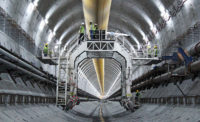In the Himalayas, road construction continues in rigorous conditions and includes the first attempt at tunneling since 1954.
Taking on this challenge of geography and geology, the National Highway Authority of India (NHAI) has embarked on an ambitious $2.5-billion plan to modernize, realign and restructure the only road route between Kashmir valley and the rest of India in the Himalayan state of Jammu and Kashmir.
“Traffic on the existing 300-kilometer, two-lane highway connecting the state’s summer capital, Srinagar, and winter capital, Jammu, was frequently disrupted for long periods due to snowfall, landslides and road fatalities,” says NHAI Chairman Raghav Chandra. “Within next three years, we will ensure safer, all-whether connectivity through a new four-lane carriageway comprising a dozen tunnels, two-dozen viaducts and 150 bridges, cutting down the distance by 60 kilometers and travel time by half.”
The NHAI is fast-tracking four of the six ongoing projects that are running behind schedule, and the federal and state governments are removing bottlenecks regarding logistics and land. Work on the two remaining stretches, which initially attracted few bidders due to low engineers’ estimates, has started after new contracts were awarded last September with upwardly revised cost estimates. All the projects, costing around $2.5 billion, are slated for completion by May 2019.
This project represents the first time intense tunneling is being undertaken in the region since 1954, when the 2.5-km-long Jawahar Tunnel was constructed.
“Unlike other parts of India, tunneling in the young Himalayas faces diverse geological problems, such as difficult terrain conditions, thrust zones, shear zones, folded rock sequence, in situ stresses, rock cover, ingress of water, geothermal gradient, ingress of gases, high level of seismicity, et cetera,” points out S.C. Mittal, chief executive for implementation with the IL&FS Transportation Network Ltd. (ITNL).
ITNL initially had selected, in 2010, Leighton India—a subsidiary of Australia-based CIMIC Group, previously known as Leighton Holdings—for design and execution but, following a financial dispute, decided to undertake the project itself.
Using the so-called New Austrian Tunnel Method (NATM), Mittal and his team have finished excavating a 9-km-long, two-lane, 13.3-meter-dia tunnel, including a parallel 5-m-dia escape tunnel, between Chenani and Nashri in the lower Himalayas. Now, crews are building support structures and electrical, mechanical and communication installations to complete the project by year's end. “It will be India’s first tunnel, with a world-class Integrated Tunnel Control System [in which] the ventilation, fire control, signals and communication will be automatically actuated,” Mittal notes.
Excavation of another 8.45-km-long tunnel project, located 100 km away and connecting Banihal with Quazigund, is 80% complete. The EPC contractor for the project, Navyuga Engineering Co. Ltd., is working with its independent consultant, SMEC India, a subsidiary of an Australian engineering and development company.
The original design consisted of a bi-directional, single-tube tunnel with two lanes, but the contractor revised it to a uni-directional twin-tube tunnel design that NHAI accepted as a better option because of technical and safety considerations. Further delay was caused by logistics and local unrest.
“Though we are using world-class technology, equipment and material, we can’t go for shortcuts at the cost of safety and ecological considerations,” says Malcolm Rankin, SMEC’s project manager for underground works. “Every bit of logistics must be organized. Spares can be a problem, and equipment lying idle can be a problem.”
Based on the Himalayas' "active" stress state, deep-tunnel excavation poses significantly more challenges than tunneling elsewhere. For example, as the world's youngest chain of mountains, the Himalayas are rising faster than any other.
The completed stretch between Jammu and Udhampur gives an idea of how construction will continue forward. On this stretch, four twin-tube tunnels—148, 250, 469 and 550 m in length, respectively, and connected by bridges and viaducts—were constructed using conventional cutting methods, including NATM, as well as specially designed roadheaders and drum-cutter and vibro-ripper attachments. To complicate construction, the tunnels run through the Nandini Wildlife Sanctuary, where blasting is banned.
“The scheduled period to complete the project was 36 months, and we were anticipating a slight delay due to topography and other problems," says R.P. Singh, NHAI project director. “But our contractor, AFCONS Infrastructure Ltd., was able to complete it before the deadline.”







